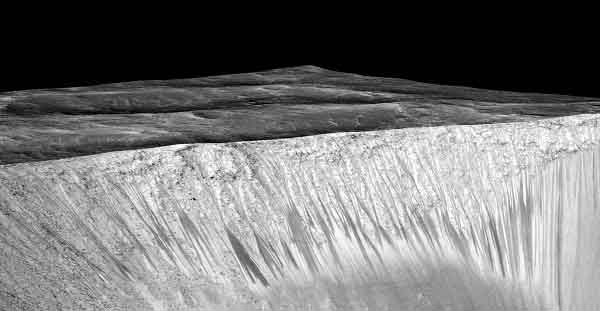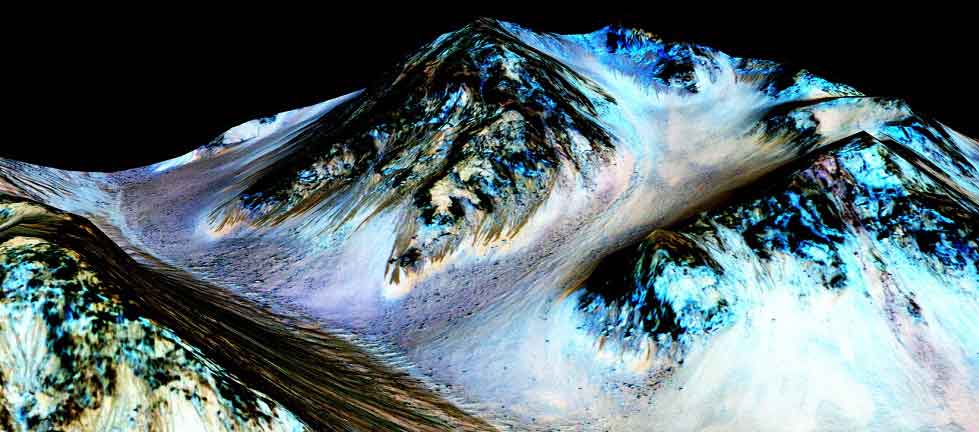NASA says it found proof of water in dark streaks, called recurring slope lineae, on the walls of the Garni Crater on Mars.
NASA announced this evidence which is its strongest yet for liquid water on the red planet, increasing the possibility that astronauts journeying to Mars could someday rely on the planet’s own water for their drinking needs.
[Rachel Feltman/The Washington Post]
Using an imaging spectrometer on MRO, researchers detected signatures of hydrated minerals on slopes where mysterious streaks are seen on the Red Planet. These darkish streaks appear to ebb and flow over time. They darken and appear to flow down steep slopes during warm seasons, and then fade in cooler seasons. They appear in several locations on Mars when temperatures are above minus 10 degrees Fahrenheit (minus 23 Celsius), and disappear at colder times.
“Our quest on Mars has been to ‘follow the water,’ in our search for life in the universe, and now we have convincing science that validates what we’ve long suspected,” said John Grunsfeld, astronaut and associate administrator of NASA’s Science Mission Directorate in Washington. “This is a significant development, as it appears to confirm that water — albeit briny — is flowing today on the surface of Mars.”
[Gina Anderson/NASA]
Dark narrow streaks called recurring slope lineae emanating out of the walls of Garni crater on Mars. The dark streaks here are up to few hundred meters in length. They are hypothesized to  be formed by flow of briny liquid water on Mars. The image is produced by draping an orthorectified (RED) image (ESP_031059_1685) on a Digital Terrain Model (DTM) of the same site produced by High Resolution Imaging Science Experiment (University of Arizona). Vertical exaggeration is 1.5. Credits: NASA/JPL/University of Arizona
be formed by flow of briny liquid water on Mars. The image is produced by draping an orthorectified (RED) image (ESP_031059_1685) on a Digital Terrain Model (DTM) of the same site produced by High Resolution Imaging Science Experiment (University of Arizona). Vertical exaggeration is 1.5. Credits: NASA/JPL/University of Arizona
“The presence of hydrated salts in these slopes mean that they’re being created contemperaneously with water,” said Luju Ojha, one of the researchers on the project, during a NASA press conference. The other key thing about this find, Ojha noted, is that because of the huge temperature swings on the Martian surface, liquid water by itself isn’t that stable. But with perchlorate salts, water can survive on Mars at much lower temperatures (just like salt on Earth prevents ice from forming).
But what’s the source of the water itself? It may be, researcher Mary Beth Wilhelm explained at the conference, that the perchlorates are absorbing water directly from the atmosphere. Thus, the water on Mars is “briny, not pure.” But it may also be that there’s a subsurface source of water causing the flows. So the source of the water is the next puzzle to be solved.
[Alex Knapp/Forbes]
While the discovery doesn’t by itself offer evidence of life on Mars, either past or present, it does boost hopes that the harsh landscape still offers some refuge for microbes to cling to existence.
“The existence of liquid water, even if it is super salty briny water, gives the possibility that if there’s life on Mars, that we have a way to describe how it might survive,” said John Grunsfeld, associate administrator for the Science Mission Directorate at NASA.
[Michael Pearson/CNN]











Comments